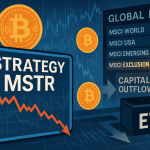
The US economy is sending mixed signals. Growth has slowed, job creation has weakened, yet prices keep rising in stubborn ways.
Consumers feel squeezed, investors are riding a stock market boom, and policymakers face a puzzle that does not fit the old playbook.
What is happening is not the stagflation of the 1970s, nor the post-pandemic overheating of 2021. It is something different. It looks like an inflation cycle driven not by wage growth or excess demand, but by rentiers and corporate margins.
Why prices rise while paychecks stagnate
The most recent data show core consumer inflation at 3.1% in July, the highest since February, while wages rose only 0.1% month-on-month.
Employers added just 73,000 jobs in July, and revisions cut prior months sharply lower, leaving the three-month average at 35,000. That is a fraction of the 127,000 average earlier this year.
Although the labor market is not overheating, it’s barely growing. Recent immigration crackdown efforts are only making things worse.
Yet prices are not settling down. Producer price data for July revealed trade margins at their highest level in more than three years. In plain terms, companies are protecting or even expanding profit margins.
And tariffs have become the perfect excuse. Since April, the Trump administration has imposed or threatened duties on goods from China, Brazil, Bangladesh, Israel and others.
Even before tariffs hit, importers stocked up to avoid higher costs. Many absorbed duties by cutting advertising or shifting budgets. Now, as inventories turn over, higher sticker prices are creeping in.
This mix creates inflation without wage relief. Workers cannot bargain for higher pay, because hiring has slowed and immigration restrictions are reducing the number of available jobs.
But consumers still face higher prices, because firms find ways to pass costs along or use the uncertainty to justify price increases.
Housing pressure comes from scarcity, not monopolies
For households, housing costs matter more than tariffs.
Shelter accounts for more than a third of the consumer price index. Here too, inflation persists.
Rents in major metro areas are rising faster than incomes. Some blame corporate landlords, pointing to firms like Blackstone or BlackRock as the culprits. But the data do not support that story.
In fact, institutional investors own less than half a percent of America’s housing stock. At the peak in 2022, corporate buyers made fewer than 5 percent of home purchases.
Research shows that when they buy properties, they often convert them to rentals, which can increase supply and lower rents locally.
The real issue is supply. Desirable cities do not build enough. Zoning rules, construction bottlenecks and now tighter immigration rules for construction workers all limit new housing.
At the same time, demand concentrates in those cities, leaving other parts of the country with affordable housing but few good jobs. That divergence creates a “local rent crisis,” instead of a nationwide one.
The political temptation is to blame corporations, but the economic reality is scarcity. As long as supply lags, shelter costs will continue to keep inflation sticky, no matter what the Federal Reserve does with interest rates.
Investment retreats, except in artificial intelligence
Beyond housing, the broader business picture is subdued. Factory construction surged in recent years as firms sought to onshore production, but investment is now falling.
Foreign companies that once saw the United States as the safest bet are more hesitant. Tariff unpredictability and tighter immigration policies make planning harder.
Instead of investing, many firms are buying back stock. That lifts share prices but does not expand capacity or create jobs.
The one exception is artificial intelligence.
Capital spending on data centers and AI computing power is surging. This single sector is propping up investment numbers and the stock market.
Yet it also raises risks. If AI returns disappoint, the economy will face another painful comedown, similar to the dot-com crash.
The AI boom also strains energy grids. Data centers are highly energy-intensive, and electricity costs are rising as capacity lags. With renewable projects slowed by federal policy, power prices are set to climb further.
That feeds directly into consumer bills, adding another rentier-style cost burden.
A stock market boom built on fragile foundations
For investors, the outlook seems brighter. The S&P 500 has gained nearly 8% this year.
After Trump’s “Liberation Day” tariff announcement in April triggered a selloff, stocks rebounded as investors bet on eventual rate cuts and survivable tariffs. Cyclical sectors from transport to materials have rallied.
But the market’s optimism sits on weak foundations. Corporate earnings are holding up, but mainly through pricing power and cost cuts. Real economic activity looks softer.
Consumer confidence has fallen since Trump took office, according to the University of Michigan survey.
The equal-weighted S&P has outperformed, suggesting breadth, but much of the enthusiasm still centers on AI.
Investors are betting that the Fed will cut rates at its September meeting. Lower borrowing costs could give cyclical stocks another lift. Yet the same cuts will not ease housing scarcity or stop firms from raising prices under the cover of tariffs.
The risk is that monetary easing fuels an asset boom while leaving consumers stuck with stagnant wages and rising costs.
What kind of inflation is this?
The term stagflation does not quite fit. In the 1970s, inflation was fueled by wages and oil shocks.
Today, wage growth is weak, and oil is not the driver. Instead, inflation is powered by rentiers: landlords constrained by zoning, utilities straining under new demand, and companies padding margins in the shadow of tariffs. It is a structural form of inflation that monetary policy struggles to address.
This regime might be called “rentier-led inflation”. It extracts more from consumers without delivering growth or security in return.
Policy choices are increasingly important. Mass deportations reduce labor supply, tariff volatility raises corporate pricing power, and the rollback of renewable energy projects tightens utility capacity.
These pressures layer on top of existing housing shortages and corporate mark-up strategies.
The outcome is clear in the numbers. Inflation above 3%. Job creation down by almost half from last year. Consumer confidence sliding.
And yet, a record stock market.
The winners are those with assets and pricing power. The losers are those earning stagnant wages and paying more for rent, food and electricity.
The post The rise of rentier-led inflation: why prices keep climbing even as growth slows appeared first on Invezz






